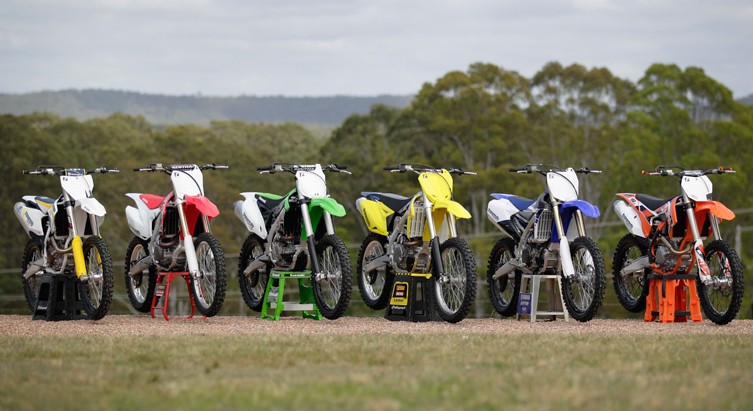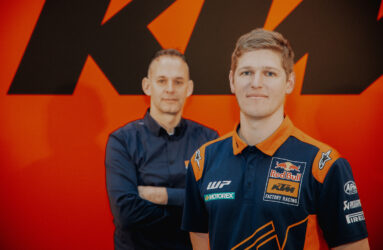2015 450cc MX Shootout: Suspension
In many ways, Transmoto‘s 2015 450cc MX bike shootout was defined by the sweeping changes to the suspension packages a majority of the bikes roll on. After all, five of the six combatants come with a completely new fork – three of which use an air-spring system, rather than the more conventional steel coil springs.
So, to get a more complete handle on each suspension package’s strengths and weaknesses, and to ensure testers didn’t get ‘lost’ in suspension adjustments during the two days of testing, we brought Teknik Motorsport’s Nick Dole to the shootout to act as an independent technician; to float between all six bikes and help us extract the key points we learned from testing these new suspension packages – the air-sprung forks, in particular – in terrain that ranged from undulating hardpack to deep, whooped-out sand.
Air-Sprung Forks
Pros
- It takes at least half an hour, a workshop and $250 to change a pair of springs in a coil-spring fork, whereas you can change the effective spring rate of an air-sprung fork in a matter of seconds for the cost of fresh air! If you’re a particularly heavy or light rider, this will save you from the inevitable need to fit different fork springs to the production machine that comes set up for the average 75-80kg rider.
- Adjustments to spring ‘rates’ can be made in smaller, stepless increments.
- Air-sprung forks save about 1kg in weight and are claimed to reduce stiction by up to 25%. That means the fork should be and more sensitive to, and compliant over, small bumps.
- The action through the stroke is theoretically smoother and more linear.
- The air can be completely removed to lower the front-end for transporting the bike.
Cons
- Having to check the pressures in the fork’s air chambers every time you ride certainly adds to a bike’s set-up complexity. Many riders struggle to fully comprehend the function of their basic clickers. So, by adding a series of air chambers and high- and low-speed clicker adjustment options on top of this, there’s a risk that the average bloke gets lost in the overwhelming range of set-up possibilities.
- A damaged fork seal on the Kayaba PSF (where the air-spring is in the outer chamber) can lead to a loss of pressure in the fork, which will cause it to ride dangerously low in its stroke.
- As the air inside the fork heats up over the course of a ride, it will in effect make the fork firmer. This may work perfectly if it firms up in concert with a deteriorating sand track, but it makes it hard to track your settings. In previous years, suspension tuners say rates varied by up to 5psi (or two spring rates). For the 2015 air forks, variations in pressure seem to have come down to 1-2psi (which is less than one spring rate of an equivalent coil-spring fork.)
Take-Out Points
- Adjustability is a great thing, but only if users understand how each of those adjustments – made in isolation and in conjunction with each other – will affect the suspension’s ride.
- For very light riders on a flat track, the Kayaba PSF2 fork’s standard 35psi works well. But for riders of average or heavy weight, the fork seems to work much better with 38-40psi – especially on bumpy and/or undulating tracks.
- Given that Honda is the only motocross bike on the market (250 or 450cc) with a Kayaba PSF fork, there’s going to be a very limited pool of data to draw from when it comes to improving its set-up.
- To minimise stiction and ensure a plush ride over small bumps, the outer chamber in Showa’s SFF-Air TAC fork is best left at 0psi. The only reason to put any pressure in the outer chamber is to improve bottoming resistance for 85kg-plus riders, and even then, only a little pressure is enough to achieve this. Adding pressure to the outer chamber places pressure on the fork’s seals, thereby increasing stiction. This is why Honda has actually blocked off the outer chamber on the SFF-Air TAC fork they fitted to their 2015 CRF250R.
- Rightly or wrongly, if a rider doesn’t like the feel in a fork, there’s a tendency for technicians to initially make changes to air pressures, rather than first tweak a few clicker settings to see if that will improve the fork’s action and ride. Air pressure is seen as the ‘coarse’ adjuster, if you like, with the clickers used to augment or fine-tune that. In other words, each time a change was made for a test rider, it tended to be a large one, which is probably what led to the wildly varying tester feedback about each fork’s feel and damping character. By comparison, a coil-spring fork comes with only two external adjustment options – compression and rebound clickers – meaning it’s much simpler to fine-tune the adjustment, albeit over a more limited range.
- As one of Australia’s most accomplished race bike tuners (who asked not to be named) said, “We might have become too clever for our own good with the level of adjustability air suspension offers us. The theory is great, but it’s yet to benefit us in practice. Like any new technology, you often have to take a step backwards to give yourself the potential to take several steps forward – in terms of both performance and adjustability. But these air-sprung bikes seem to have turned into a bloody woman’s wardrobe; you never know what to change first! Air suspension is here to stay, but if riders and technicians want to stop chasing their tails, I think it’s inevitable that the manufacturers dumb down the adjustment options in the years to come. Adjustment is no good unless people understand how to use it.”
- And, lastly, isn’t the fork only half of a dirt bike’s suspension equation? With coil springs, a change of just one or two rates in the fork spring will always be accompanied by a corresponding change in the shock absorber spring on the rear to maintain the bike’s chassis geometry and balance. With air forks, however, riders are making air pressure changes that equate to two, three or more spring rates, and yet not making a corresponding change to the shock. Which kind of suggests that the real benefit of air-sprung suspension will begin when the major suspension manufacturers begin making air-sprung shock absorbers as well. We all know that WP has produced an air shock that works well, but which was put back in mothballs after its very public failure 18 months ago in the AMA Supercross series (remember Ryan’s Dungey’s rear-end collapsing on the start line in 2013?). But don’t for a minute think air shocks are gone forever.
Suspension Settings
Click to enlarge…
Video
For a comprehensive insight into the six bikes’ relative performance, and how we scored and ranked them after two days of testing, grab yourself a copy of the January-February issue (#48) of the magazine, which went on sale December 29, 2014. You can grab a copy at your local newsagents, or digitally using the App Store or Zinio.










Be the first to comment...